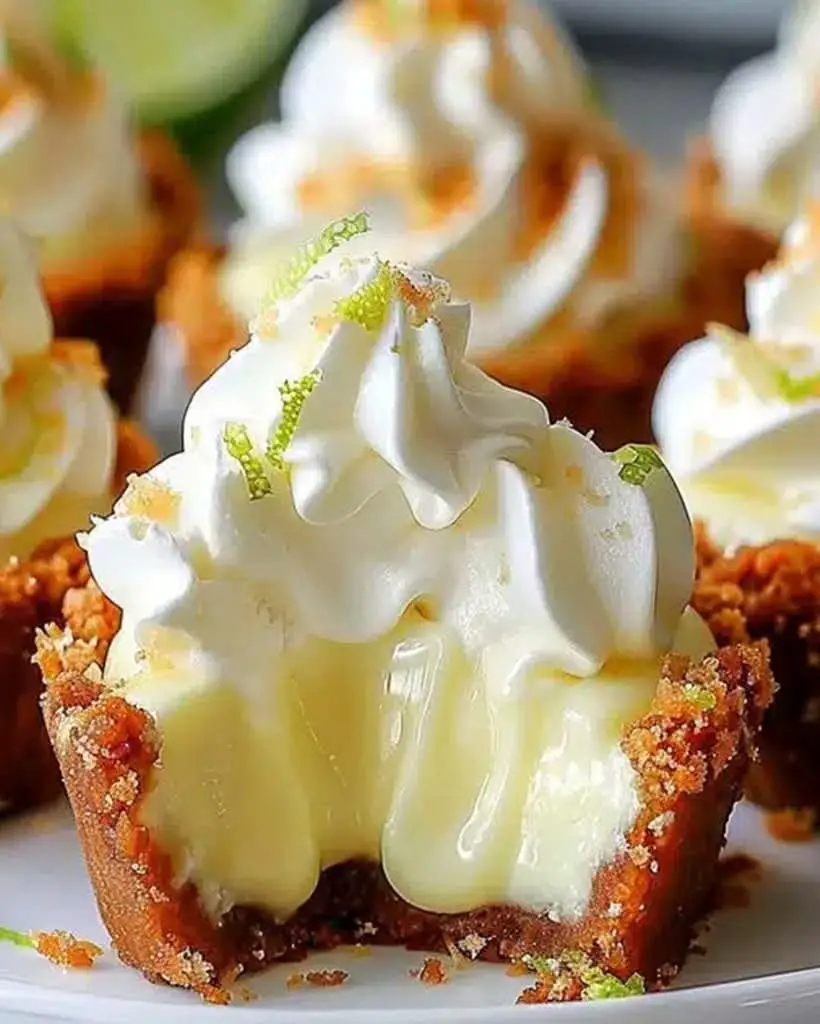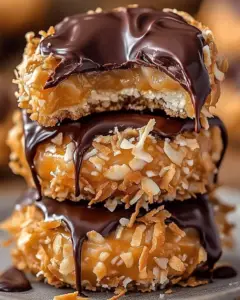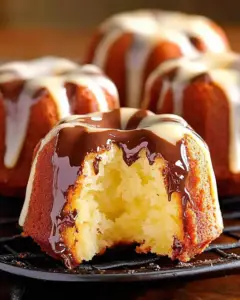No-Bake Mini Key Lime Pies: Tangy Delight in Bite-Sized Treats
Welcome to the ultimate guide on crafting No-Bake Mini Key Lime Pies, a dessert that packs a zesty punch in every bite. These petite pies capture the essence of classic key lime pie recipes, delivering creamy, tangy flavors without any baking required. Ideal for those warm summer days or any time you crave a citrusy treat, these pies are as refreshing as they are simple to make. With their delicate balance of sweet and tart, these No-Bake Mini Key Lime Pies are sure to become a favorite in your dessert repertoire.
Quick Recipe Highlights
- Flavor Profile: These mini pies boast a tangy lime flavor complemented by a sweet, creamy filling. The zestiness of the key lime pairs beautifully with the sweetness, offering a refreshing taste with every bite.
- Texture: The silky-smooth filling contrasts with the crumbly, slightly crunchy crust, creating a delightful mouthfeel that is both rich and satisfying.
- Aroma: The fresh lime aroma is both invigorating and mouthwatering, hinting at the vibrant flavors that await.
- Visual Appeal: With their bright green filling atop a golden crust, these pies are visually striking, adding a pop of color to any dessert table.
- Skill Level Needed: With straightforward, no-bake steps, these pies are suitable for novice and experienced bakers alike.
- Special Equipment: A mini muffin pan is essential to creating the perfect size for these bite-sized delights. You might also want a citrus zester for the freshest lime flavor.
Recipe Overview
- Difficulty Level: This recipe is classified as easy due to the simplicity of the steps and the absence of a baking phase, making it perfect for bakers of all levels.
- Category: No-Bake Mini Key Lime Pies are ideal for any dessert occasion, whether a casual family meal or a more formal gathering.
- Cuisine: These pies draw inspiration from American cuisine, particularly that of the Florida Keys, which is home to the original key lime pie.
- Cost: The cost is modest, as the primary ingredients are common staples found in most kitchens, such as graham crackers, cream cheese, and limes.
- Season: While these pies can be enjoyed year-round, they’re particularly refreshing during the spring and summer, when lighter, fruit-based desserts are favored.
- Occasion: Perfect for summer parties, picnics, or casual get-togethers, these pies are a hit wherever a refreshing dessert is desired.
Why You’ll Love This Recipe
The taste and texture of these No-Bake Mini Key Lime Pies are irresistible. Their tangy lime filling balances perfectly with the sweetness of the crust, offering a mouthwatering experience. The filling’s smoothness against the crumbly graham cracker crust is a testament to thoughtful dessert-making.
Convenience is key with this no-bake recipe, as it requires minimal kitchen effort. The simplicity of preparation—just mix, fill, and chill—means you can have a delightful dessert ready without the fuss of baking or precise temperature control.
Nutritionally, these pies offer the benefits of limes, which are rich in vitamin C and antioxidants. While these are still indulgent, knowing they contain some nutrients adds a small health advantage to your treat.
For social gatherings, these mini pies shine as they are easy to serve and present attractively on any dessert table. Their individual size makes them perfect for parties, allowing guests to enjoy a whole dessert without slicing or serving.
Lastly, their cost-effectiveness and accessibility make this a go-to dessert. Ingredients are easily found at your local grocery store, and since there’s no cooking, energy costs remain low, making this an economical choice for any occasion.
Historical Background and Cultural Significance
The origin of key lime pie is deeply rooted in the history of the Florida Keys. With the introduction of key limes to Florida from the West Indies, the recipe was developed by local residents using readily available ingredients.
Culturally, key lime pie has become synonymous with Floridian cuisine, a staple dessert proudly served in eateries across the state. Its tangy, refreshing flavor mirrors the coastal environment and the vibrant culinary traditions of the region.
Over time, the recipe has evolved from its basic origins to include variations such as these no-bake versions. This adaptation maintains the essence of the original while offering a modern take that aligns with today’s fast-paced lifestyle.
Regional variations often include different toppings or crust types, ranging from traditional sweetened whipped cream to more complex meringue toppings, each bringing a subtle twist to the classic flavors.
Ingredient Deep Dive
Key Limes, the star of the show, are smaller and more aromatic than regular limes, offering a distinct flavor that’s both sweet and tart. Historically, these were used extensively in Floridian and Caribbean desserts for their unique taste profile.
Nutritionally, key limes are a good source of vitamin C, known for boosting the immune system and improving skin health. Selecting perfect limes involves choosing fruits that are smooth and free of blemishes, indicating freshness and better juice quality.
Proper storage of key limes involves keeping them at room temperature if being used within a week, or refrigerating for up to two weeks. Alternatively, freezing lime juice in ice cube trays is a practical way to extend their usability.
Common substitutions for key limes include regular limes in a pinch; however, the flavor will be less intense. In terms of flavor, bottled key lime juice can also serve as a substitute, although it lacks the aromatic zest of fresh limes.
Common Mistakes to Avoid
- Overfilling the pie crusts can lead to messy serving and improper setting, so it’s crucial to measure the filling appropriately.
- Using regular limes without zesting can result in a bland flavor, as zest provides essential oils that enhance lime taste.
- Not chilling the pies long enough can affect the texture, so ensure adequate refrigeration time for proper setting.
- Using low-fat cream cheese can alter the creamy consistency; full-fat works best for the ideal texture.
- Skipping the lime zest will deprive your pies of their vibrant lime aroma and flavor, which are key to their allure.
- Undertreating the crust can lead to a crumbly finish; ensure crust components bind well for structure.
- Ignoring proper portioning leads to uneven sizing; use a mini muffin pan for consistent minis.
- Refrigerating uncovered can cause drying out and flavor loss, so cover with plastic wrap to maintain freshness.
Essential Techniques
Creating the perfect graham cracker crust is vital for texture balance in No-Bake Mini Key Lime Pies. The crust’s compactness ensures it holds the creamy filling without crumbling. To master this, ensure butter thoroughly binds the crumbs before pressing into pans.
Mastering the filling involves achieving a smooth, lump-free consistency. This is best accomplished by room-temperature cream cheese to facilitate effortless mixing, preventing chunks and ensuring a homogenous blend.
Avoid overmixing the filling, which can incorporate excess air, causing a mousse-like texture when you’re aiming for creamy. Mix just until smooth, ensuring flavors meld without compromising the silkiness.
Visual cues for success include a glossy finish on the filling paired with a firm-touch crust, indicating proper chilling and setting. These key techniques ensure your pies are both delectable and delightful to both see and eat.
Pro Tips for Perfect No-Bake Mini Key Lime Pies
For enhanced lime flavor, add extra zest to the filling. This not only intensifies the lime taste but also adds aromatic richness. Furthermore, a hint of salt in the crust balances sweetness and accentuates the pie’s tartness.
Achieve a creamier texture by chilling the mixture before use. Cooler temperatures help firm up the filling, creating a more pleasant mouthfeel when paired with a crunchy crust.
Equipment matters, so using a mini muffin pan ensures uniform size, optimal chilling, and easy serving. The individualized portions are perfectly bite-sized, creating a pleasing dessert experience.
To avoid over-sweetness, taste the filling along the way. If needed, balance it out with more lime juice. A balance between the sweet and sour elements is critical to a tantalizing dessert.
By investing in quality key limes, you can significantly elevate the overall flavor of the pies. Fresh lime juice and zest can transform the recipe from merely good to truly exceptional.
Lastly, to streamline preparation, crush graham crackers in a food processor for an even texture. This ensures consistent crust results while saving time.
Variations and Adaptations
Regional variations include the addition of coconut flakes to the crust, which provides a delightful tropical hint and harmonizes with the lime’s zingy flavor. This adaptation suits the dessert well to more tropical or Caribbean-inspired meals.
Seasonal adaptations may involve using Meyer lemons or blood oranges when key limes are out of season. These fruits bring their own unique zing and subtle sweetness, offering a fresh twist on the classic recipe.
For dietary modifications, substitute gluten-free graham crackers to cater to gluten-sensitive guests. This simple swap maintains the flavor while ensuring inclusivity at the dessert table.
Flavor variations can involve experimenting with different citrus fruits beyond lime, such as a mixed citrus pie using lemon, orange, or even grapefruit juice, providing a dynamic shift in taste.
Texture modifications include adding a layer of whipped topping for a creamy contrast to the zesty filling. This addition not only balances flavors but also lightens the pie’s overall texture.
Presentation alternatives may involve serving the pies in clear cups for a more sophisticated take, where the layers are distinctly visible, adding visual appeal to your dessert offerings.
Serving and Presentation Guide
Plating these mini pies is straightforward yet impactful. Arrange them on a tiered dessert stand for elegance or serve them individually on small plates for a more personalized touch.
Garnishing ideas include freshly grated lime zest for a pop of color and an added burst of aroma. Alternatively, garnish with a small dollop of whipped cream and a slice of key lime for a classic finish.
Traditional accompaniments include a light coffee or unsweetened tea, which balance the sweetness of the pies. For a modern twist, pair them with a citrus spritz cocktail for a complementary summery refreshment.
The optimal serving temperature is chilled to maximize the dessert’s refreshing qualities. Ensure hands remain cool while handling when serving the chilled pies to keep them looking pristine.
Portion control tips emphasize the importance of serving size, as these pies are rich in flavor; a single mini size sufficiently satisfies most palates without overwhelming.
Wine and Beverage Pairing
For wine pairings, a crisp Sauvignon Blanc or a sparkling wine complements the tangy zest of key lime without overshadowing it. These wines provide a fresh counterbalance to the dessert’s creamy texture.
Non-alcoholic alternatives such as a lime-infused sparkling water or an iced green tea enhance the citrus notes in the pies, providing a refreshing counterpart to these flavorful desserts.
If pairing with coffee or tea, opt for a lightly brewed coffee or a green tea. These beverages enhance the zesty notes of the pie while providing a warm, comforting counterpart to the chilled dessert.
Consider serving both chilled and unsweetened to maintain harmony with the dessert’s sweetness, ensuring the pies remain the focal point of the tasting experience.
Serving suggestions include small, decorative glasses to add sophistication to your presentation and align beverage aesthetics with the bright, vibrant colors of the pies.
Storage and Shelf Life
Proper storage of No-Bake Mini Key Lime Pies extends their freshness and maintains their flavor. Refrigerate the pies in an airtight container to prevent drying and protect their delicate textures.
Temperature requirements emphasize keeping the pies consistently chilled. Ideally, store between 34°F to 40°F to ensure the filling remains firm and delightful.
Container recommendations include glass or hard plastic to avoid any flavor transfer and maintain structural integrity for each pie. Avoid using metal containers, which can alter the taste over time.
Signs of spoilage include discoloration of the filling and a soggy crust. A distinct smell can also indicate the pies are past their prime; prioritize consuming within three days of preparation.
Reheating is not recommended as these pies are meant to be enjoyed cold; however, ensure they reach room temperature briefly before serving to enhance their flavors.
Freezing guidelines suggest avoiding as texture changes may occur. If necessary, freeze only the crusts, filling upon serving for closest freshness, though flavor may slightly diminish.
Make Ahead Strategies
For preparing in advance, create the crust and filling separately up to 24 hours ahead of time, storing both in the refrigerator. This timeline ensures minimum effort on the serving day while preserving freshness.
Store the components well-covered to avoid drying: use plastic wrap or sealed containers for effective moisture retention and overall quality maintenance.
To ensure optimal taste, assess any quality changes like texture or flavor loss, and stir filling lift peaks if settling occurs to restore smoothness before assembling.
Assembly tips emphasize careful and balanced filling distribution among the crust bases, maximizing the pies’ taste and presentation impact upon serving.
Reheating guidelines don’t apply here; however, bringing the pies out of refrigeration shortly before serving ensures they reach ideal serving temperature for maximum enjoyment.
Fresh element additions like a garnish should be added just before serving to maintain vibrancy and aroma, ensuring each mini pie carries a delightful accent that enchants the senses.
Scaling Instructions
When halving the recipe, maintain the ingredient ratios to ensure flavor balance. Scaling down avoids excess leftovers and suits smaller gatherings effectively.
For doubling or tripling, pay careful attention to ingredient proportions, extending chill times slightly to accommodate thicker filling volumes while achieving the desired texture.
Equipment adjustments may involve larger storage solutions or multiple muffin pans to handle increased batch sizes, remembering to maintain even filling across all pies.
Modify timing based on batch size; larger quantities might need extended chill time to reach the proper setting firmness, ensuring consistent texture throughout all servings.
Storage considerations scale similarly; additional pies require more storage space and strategic placement to avoid crowding, preserving the ideal quality till serving.
Nutritional Deep Dive
Macro breakdown reveals these pies comprise primarily carbohydrates from the crust and fats from the creamy filling, with balanced sugar for sweetness.
Micronutrient analysis highlights vitamin C and calcium presence, derived from fresh lime and dairy components, enriching their nutritional appeal without significant calorie inflation.
Health benefits connect largely to the key lime’s antioxidant properties, offering slight immune support while primarily serving as an indulgent dessert treat.
Dietary considerations note the presence of gluten in traditional crusts and dairy in filling, limiting suitability for those with intolerance without specific recipe adaptations.
Portion analysis indicated individual serving control, encouraging mindful enjoyment without excess consumption, as their richness satisfies swiftly.
Weight management tips recommend indulging moderately, leveraging the small size to satisfy dessert cravings while maintaining nutritional balance.
Dietary Adaptations
For gluten-free options, swap out regular graham crackers for gluten-free varieties in the crust, maintaining the dessert’s integrity without gluten exposure.
Dairy-free versions can replace cream cheese with coconut cream or other dairy-free alternatives, combining with traditional lime elements for a fully dairy-free experience.
Vegan adaptations require both dairy substitutes and binding alternatives like agar or plant-based gels for the filling, ensuring a cruelty-free dessert offering.
Low-carb versions substitute regular sweeteners with keto-friendly options, adjusting to minimize carbohydrate impact while preserving the dessert’s tangy charm.
For keto enthusiasts, pairing coconut flour in crusts aligns with diet needs, marrying low-carb ideals with the zesty key lime traditional flavor brilliance.
Paleo adherents combine nut-based crusts with natural sweeteners infused with organic lime, crafting a dessert aligned philosophically with paleo principles without compromising taste.
Low-FODMAP versions focus on individually crafted crusts and using lactose-free dairy substitutes, offering sensitivity-aligned choices without forgoing traditional dessert enjoyment.
Troubleshooting Guide
For texture issues, ensure filling stands adequately cooled before serving to prevent undesired softness; cooling ensures proper setting without internal liquidity.
Achieving flavor balance necessitates adequate lime infusion while ensuring sweetness doesn’t overpower, tasting periodically instead of overwhelming acidity.
Temperature problems typically occur with inadequate chilling time; ensure strategy aligns with recommended refrigeration for best setting impact and structure retention.
Equipment challenges often direct toward utilized pans; proper cutting edges or liners assist in pie removal without compromising presentation or integrity in serving.
When ingredient substitutions are involved, consult accurate conversion guides to maintain consistency in texture and taste, ensuring compatibility across dietary needs.
Timing concerns address gradual filling processes, balancing swift crust settings with adequate cooling for their harmonious blend in creating the dessert’s iconic nature.
Recipe Success Stories
Community feedback consistently reveals praise for the pies’ refreshing taste and convenience, cementing their place as a cherished choice among families seeking quick desserts.
Variation successes like the inclusion of mangosteen juice or passion fruit pulp showcase the adaptability of base recipes, where slight flavor adjustments enhance excitement.
Adaptation stories center around gluten-free transformations that retain classic tastes, committing to dietary needs without losing inherent flavor consistency over adjusts.
Reader suggestions highlighted small format cheesecakes, using plain bases with varied fruit-infused fillings to match personal flavor twists aligned to base recipe principles.
Photography tips stress utilizing natural light to capture the fresh tones and attractive elements showcased in the pie’s simplicity, appealing to visual interest regardless of additional props.
Frequently Asked Questions
Can I use regular limes instead of key limes in this recipe?
Yes, you can substitute key limes with regular limes, although the flavor will be slightly less tart and aromatic. For a closer match to key lime flavor, add a bit of lime zest to intensify the citrus profile.
How long can the pies be stored in the fridge?
No-Bake Mini Key Lime Pies can be stored in an airtight container in the fridge for up to three days. Ensure they are well-covered to avoid dryness or flavor absorption from other foods in the fridge.
Can these pies be frozen?
While freezing is possible, it may affect the texture of the pies upon thawing. For best results, enjoy them fresh or refrigerated within the recommended time frame for optimal quality.
Why is my filling not setting properly?
Ensuring proper chilling time is crucial for the filling to set. Allow the pies at least two hours in the refrigerator, preferably overnight, to achieve the desired firmness and texture.
Can I make these pies without using a muffin pan?
Using a muffin pan helps keep the pies uniformly shaped and portioned, but you can alternatively use silicone molds for flexible, non-stick options that also simplify pie removal.
What is the best way to add decoration to my pies?
For visual flair, top your pies with a dollop of whipped cream and a thin lime wedge or a sprinkling of lime zest. These embellishments add color, aroma, and a touch of elegance to your presentation.
How can I adjust the sweetness of the filling?
Taste the filling as you prepare it and adjust the sweetness by gradually adding your choice of sweetener until you reach your desired flavor profile. Remember that chilling can mellow sweetness, so aim slightly stronger at first.
What do I do if my crusts seem crumbly?
If your crusts crumble, consider slightly increasing butter content to bind ingredients better or compact crusts thoroughly in their molds to enhance their cohesion during chilling periods.
Are there any alternative crust options?
Yes, you can use crushed pretzels, shortbread cookies, or digestive biscuits for different textures and flavors, maintaining baseline ratios for crust creation while exploring complementary tastes.
How do I prevent filling overflow?
When adding the filling, use a piping bag to easily control portions, filling just to rim level without exceeding capacity—aids prevent spillover during setting and ensures presentation neatness.
Additional Resources
Explore related recipes like lemon tart or coconut cream pies for a similar taste experience applied with different citrus twists, leveraging base skills already honed for greater kitchen adventure.
Technique guides expand upon zesting and juicing methods utilizing citrus-saving tips, providing insight into maximizing flavor through minimum waste across multiple recipe applications.
Ingredient information delves into citrus history and uses beyond common applications in both sweet and savory settings, enhancing comprehensive culinary understanding relevant here and broadly.
Equipment recommendations cover essentials like quality tart molds and juicers, defining core tools for successful pie making both in preparation and technique demonstration contexts.
Seasonal variations encourage fruit-based creativity depending upon regional and seasonal availabilities, inspiring diverse summer pie works fit for warm winds or cozy recollections.
Print
No-Bake Mini Key Lime Pies Recipe
Description
These refreshing mini key lime pies are perfect for a quick and easy dessert without the need for baking.
Ingredients
For the Crust:
- 1 cup graham cracker crumbs
- 1/3 cup melted butter
- 1/4 cup sugar
- 1 can (14 oz) sweetened condensed milk
- 1/2 cup key lime juice
- 1 cup heavy cream, whipped
Instructions
1. Prepare the Crust:
- Mix graham cracker crumbs, melted butter, and sugar in a bowl. Press the mixture into the bottom of mini pie molds.
- Whisk together the sweetened condensed milk and key lime juice until smooth. Pour the filling over the crusts.
- Chill pies in the refrigerator for at least 2 hours. Top with whipped cream before serving.
Notes
You can customize the seasonings to taste.




